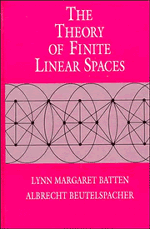Book contents
- Frontmatter
- Contents
- In memory of PAUL de WITTE 1931–1980
- Preface
- 1 The essentials
- 2 Complementation
- 3 Line sizes
- 4 Semiaffine linear spaces
- 5 Semiaffine linear spaces with large order
- 6 Linear spaces with few lines
- 7 d-Dimensional linear spaces
- 8 Group action on linear spaces
- Appendix
- Notation index
- Subject index
1 - The essentials
Published online by Cambridge University Press: 05 May 2010
- Frontmatter
- Contents
- In memory of PAUL de WITTE 1931–1980
- Preface
- 1 The essentials
- 2 Complementation
- 3 Line sizes
- 4 Semiaffine linear spaces
- 5 Semiaffine linear spaces with large order
- 6 Linear spaces with few lines
- 7 d-Dimensional linear spaces
- 8 Group action on linear spaces
- Appendix
- Notation index
- Subject index
Summary
Definitions and examples
Definition: A linear space is a pair S = (p, ℒ) consisting of a set p of elements called points and a set ℒ of distinguished subsets of points, called lines satisfying the following axioms:
(L1) Any two distinct points of S belong to exactly one line of S.
(L2) Any line of S has at least two points of S.
(L3) There are three points of S not on a common line.
It is clear that (L3) could be replaced by an axiom (L3)': There are three lines of S not incident with a common point. In any case, (L3) and (L3)' are ‘non-triviality’ conditions. The readers should quickly describe those systems satisfying (LI) and (L2) but not (L3). These are called trivial linear spaces.
Points will usually be denoted by the lower case letters p, q, s,…, x, y, z, and lines by the upper case letters L, M, N,…, X, Y, Z.
The line through the distinct points p and q will be denoted by pq. If two distinct lines L and M intersect in some point, then their (unique) point of intersection will be denoted by L ∩ M.
We shall use ‘geometric’ language such as ‘a point is on a line’, ‘a line goes through a point’ and so forth, rather than confining ourselves to precise set-theoretic terminology.
Throughout this book we shall be restricting ourselves to finite linear spaces, that is, to linear spaces for which the point set is finite.
- Type
- Chapter
- Information
- The Theory of Finite Linear SpacesCombinatorics of Points and Lines, pp. 1 - 21Publisher: Cambridge University PressPrint publication year: 1993



